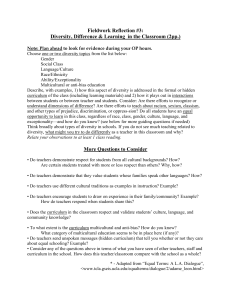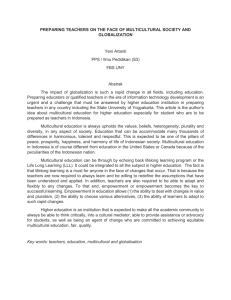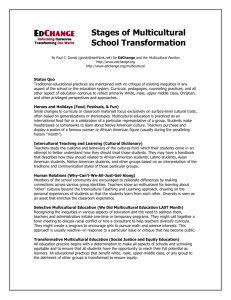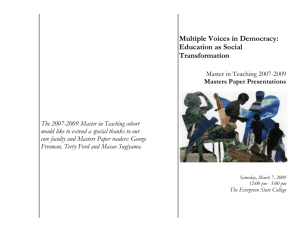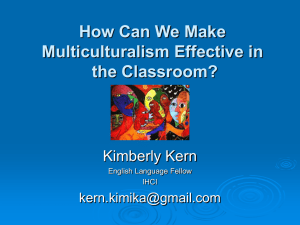Multicultural Perceptions Held by Preservice
advertisement
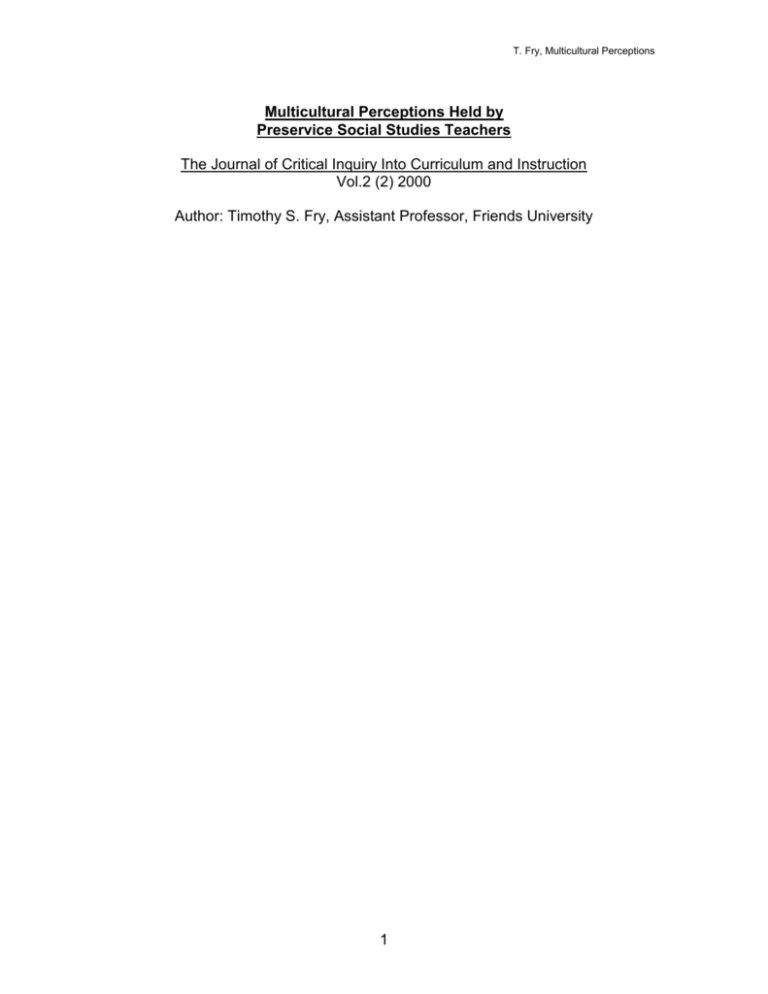
T. Fry, Multicultural Perceptions Multicultural Perceptions Held by Preservice Social Studies Teachers The Journal of Critical Inquiry Into Curriculum and Instruction Vol.2 (2) 2000 Author: Timothy S. Fry, Assistant Professor, Friends University 1 T. Fry, Multicultural Perceptions Abstract Many curriculum guides and standards for social studies instruction call for more emphasis of multicultural concepts. However, a multicultural approach to the social studies has not gained universal acceptance. This study examined the perceptions that preservice social studies teachers had of multicultural education. An assumption of the study was that the perceptions these prospective teachers have regarding multicultural education would be useful to enhance social studies teacher education programs. The results showed that while many saw a connection between multicultural education and social studies, many multicultural concepts were not very well understood by these prospective social studies teachers. 2 T. Fry, Multicultural Perceptions Multicultural Perceptions Held by Preservice Social Studies Teachers Multicultural education seems to have finally made it on the agenda as many educational leaders, educational journals, and national standards reformers have pointed out the many merits of this approach. A general consensus is that while multicultural education needs to be addressed across the curriculum, it is possibly most easily introduced to the social studies curriculum. As James Banks (1991) points out, multicultural education not only deals with attitude and achievement of students but also addresses the need for historical accuracy and America's commitment to democratic ideals. Those ideals and values expressed in the Constitution and Bill of Rights provide the basis for teaching in social studies classrooms (McGuire, 1992) and as Jim Boyer (1991) aptly suggests, the "thrust" behind multicultural education is to bring American schools into alignment with the major founding documents of the United States. Different versions of national standards for the social studies, as well as many state and local school district curriculum guides for social studies instruction, call for more emphasis of several multicultural concepts. The national standards for social studies produced by the UCLA Center for History called for a broader view of world cultures and social trends, including the portrayal of women and minorities, than might normally be found in textbooks for grades 5-12. This guide also proposed grade level standards for teaching history in kindergarten through the fourth grade. Students in the early grades would read biographies and create portraits of famous people with props that represent their accomplishments--like George Washington Carver with a peanut or Marie Curie with a test tube. Third and fourth graders would make annotated scrapbooks that describe significant technological achievements in various 3 T. Fry, Multicultural Perceptions historical societies--like paper in China, Mayan calendars, and astronomical discoveries in the Muslim world (Eskey, 1994). While generally accepted and espoused by educational leaders, a multicultural perspective to the social studies has not gained universal acceptance. In January 1995, the United States Senate voted 99-1 to repudiate the national standards for teaching history developed at UCLA mentioned above. In this non-binding vote, the Senate judged the guide inappropriate for use in American education. Critics said the standards de-emphasized Western themes while down playing founding fathers like George Washington and giving little attention to the Constitution (Eagle, 1995). Gary Nash, co-director of the history standards project and history teacher at UCLA, denied the proposed standards de-emphasize Western heritage. Nash said, "Of all civilizations, Western civ gets the most play" (Eskey, 1994). Some in the media have used the term "revisionist" when an attempt is made to clarify the historical record through the use of new or additional perspectives (McGuire, 1992). People who believe there is just one story to be told about a historical event accuse these revisionists of undermining the mainstream culture. Other critics have suggested that multiculturalism in social studies is "feel good history," "ethnic cheer leading" or watered down curriculum (Singer, 1994). On the contrary, as Alan Singer (1994) puts it, "multiculturalism... is an expanded and more detailed picture of the social, cultural and intellectual history of our country and world". Disregard for multiculturalism in social studies shows not only a basic lack of understanding of multicultural concepts but of the social science discipline itself. Good social studies education is virtually synonymous with multicultural education. For example, a major concept of multicultural education and an 4 T. Fry, Multicultural Perceptions overarching principle basic to understanding the discipline of the social sciences or history is the idea of "multiple perspectives.” This concept says it is possible to view an idea, event or era in more than one way. One example lies in the Anglocentrism of an American history class that begins with the English settlements in the seventeenth century, giving scant attention to the Spanish that explored and settled much of the South and Western United States a century before and completely ignoring the Native Peoples with words and phrases like "discovered" and "how the West was won.” The "west" itself is a European perspective because for the Native Americans it was the center of their world (Willis, 1993). This perspective needs to be tempered with "already settled" or from a more Native American perspective in "How the West was Lost" (Hutcherson, 1995). While current and prospective social studies teachers may be familiar with the concept of multiple perspectives as an important social studies concept, these educators also need to realize it as a major concept of multiculturalism. Students need to be taught that all history needs to be interpreted through different eyes and from different times and places. If students realize the many different mental images there are in the world, they can begin to have multicultural understandings by accepting and affirming difference. The social studies teacher is in the social reconstructionist position to help turn the "agenda toward the mutual betterment of human understanding" (Pahl, 1992). Another important concept in multicultural education that should be thought of as good social studies is cultural pluralism. Cultural pluralism is the acceptance of multiple identifications and loyalties in a single nation-state (Cushner, 1992). Ideally, various ethnic groups would have equal rights and be able to foster and preserve their cultural beliefs and traditions (Suzuki, 1979). Under cultural pluralism, diversity is regarded positively as a strength rather than 5 T. Fry, Multicultural Perceptions negatively as a deficit. One analogy is of a musical instrument that sounds good by itself but when included as part of an orchestra has even greater value. Another argument for cultural pluralism comes from the field of biology in that positive adaptation comes from a large gene pool (Howard, 1993). Our democratic form of government is also strengthened by cultural pluralism. To be a political democracy, a country must also be a cultural democracy (Cushner,1992). A standardized philosophical cultural heritage without an attempt to "integrate disparate paradigms into public discourse" invites stagnation and civil unrest (Lesourd, 1991). Central democratic values claim a strong conviction for the worth of each individual, equality and justice for all. The opposite of cultural pluralism is the assimilationist idea of the "melting pot.” The phrase "melting pot" came from the name of a play by Israel Zangwill in which the mutual mixing of cultures would result in one large truly American culture (Zangwill, 1909). Throughout the twentieth century, this melting away of traditional cultures has been taught as an ideal and also as a historical fact in social studies classrooms. Many Americans still view this melting pot theory as the best description of interethnic relations in this country (Janzen, 1994). In fact the melting pot is a myth and does not provide an accurate historical account nor, as pointed out above, is it an ideal state for a democracy and our society in general. The history of the melting pot myth can be traced to around the turn of this century, when the largest migration of people in the history of the world came to the United States lured by jobs in a major era of industrialization. These 40 million people, mainly from Eastern and Southern Europe, created an obvious number of social problems in our choked cities. In a reactionary movement known as Nativism, violence including lynching, was directed at these "white ethnics" by many in the dominant white, Anglo-Saxon, Protestant culture (Suzuki, 6 T. Fry, Multicultural Perceptions 1976). This movement was followed by the Americanization movement directed at the children of these immigrants and carried out in the nation's public or common schools. With an Anglo-centric curriculum, children were punished for use of mother tongues and their cultural traditions denigrated. Instead of melting equitably in the American stew, non-Anglo-Saxon traditions were melted away as most immigrants found themselves pressured to shed their cultural beliefs and practices. The historical reality is one of pain, suffering and loss of culture as many Europeans even gave up their names if immigration officials could not pronounce it (Howard, 1993). Social studies teachers must attempt to provide a more accurate historical account of interethnic relations in this country. To complete the historical picture presented above, a special emphasis needs to be placed on the civil rights movement in social studies classrooms. This movement, with its demonstrations, court decisions and legislation was the major catalyst for the emergence of cultural pluralism in the United States (Baptiste & Baptiste, 1979). Another multicultural related concept that makes for good social studies is the concept of culture. Culture could be defined as "learned behaviors, traditions, and ways of life shared from one generation to the next." A key element in the transmission of that culture is family. Students need to know about their family heritage and also each student needs to be "visible" to see where their ancestors fit into the historical picture. We all have culture and ethnicity and students, as well as teachers, need to explore the similarities and differences in the human experience (Singer, 1994). A major part of culture that tends to be ignored in social studies classrooms is religion (Haynes, 1987). Even though it is a sensitive issue, that old saying of "talk about anything but religion and politics" cheats students from an historical and current socio-political understanding of the world today. Our 7 T. Fry, Multicultural Perceptions calendar and system of keeping time is based on a religious event --A.D. 1998. My own experience with students is that most of them have little idea why we date things with the number one thousand, nine hundred, and ninety eight. Major wars (Crusades and Reformation) have their basis in religion and are essential for understanding current political boundaries, migrations of people and even current political hot spots like Northern Ireland. Ignorance of religion is so rampant that on numerous instances I have heard statements from students such as "I'm not a Christian, I'm a Baptist" or "I'm not a Christian, I'm a Catholic." Purpose of the Study Little research seemed to be devoted to the examination of the perceptions that preservice social studies teachers have regarding multicultural education. Once we know the perceptions that prospective social studies teachers have of multicultural education, social studies teacher education programs can be re-designed to better address the cause for social and academic justice. This study is based on one important assumption--a long range goal should be to institutionalize the broader and more inclusive concepts of multiculturalism in social studies instruction. If prospective social studies teachers do not understand multicultural concepts or see their role, this goal will never happen. Research Questions Examined 1. What are the perceptions that preservice social studies teachers have regarding multicultural education? 2. What are the perceptions that preservice social studies teachers have of the connection between the goals of multicultural education and the social studies? 3. What multicultural concepts do preservice social studies teachers perceive as essential for inclusion in social studies classrooms? 8 T. Fry, Multicultural Perceptions Population The target population for this study was preservice social studies teachers in Kansas enrolled in a social science methods course. The sample consisted of one hundred and one (101) students. The participants included virtually all students enrolled in secondary social studies methods classes at the six Kansas Regents' Universities, Washburn University, and a consortium of schools called the Associated Colleges of Central Kansas (ACCK). Data Collection An instrument called the “Multicultural Perceptions of Preservice Social Studies Teachers” was administered during regular class meetings of social studies methods classes at the various schools. Description of Instrument The "Multicultural Perceptions of Preservice Social Studies Teachers" (MPPSST) was constructed principally by the investigator. However, patterns and ideas were adopted from other surveys or checklists including the Perceptions of Ohio Middle and Junior High School Principals Concerning Multicultural Education by Dees (1993) and the Multiethnic Education Program Evaluation Checklist published by the National Council for the Social Studies. The MPPSST uses a Likert-type scale to determine preservice social studies teachers’ perceptions of multicultural concepts. Of the twenty-five questions on the MPPSST, five questions related to the study’s Research Question Two on the connection between the goals of multicultural education and social studies. Twelve of the twenty-five questions related to the study’s Research Question One that examined perceptions of multicultural education concepts. Eight of the questions examined the study’s Research Question Three on perceived essential content of multicultural concepts in social studies instruction. Ten questions were non-multicultural or negative multicultural 9 T. Fry, Multicultural Perceptions concepts. For example, Question Eight on the MPPSST was "The analogy of a 'melting pot' is essentially a good and accurate description of interethnic relations in American History.” Summary of Findings This study explored three areas involving the perceptions of preservice social studies teachers and multicultural education. Part of the study investigated the perceptions that preservice social studies teachers in Kansas have of multicultural education concepts. Another part of the study examined the perceptions that these preservice social studies teachers have of the connection between the goals of multicultural education and the social studies. A third part of this study attempted to ascertain multicultural concepts that preservice social studies teachers in Kansas perceive as essential to include in social studies classrooms. In the part of the study that dealt with these prospective teachers’ perceptions of the connection between the goals of the social studies and multicultural education, they were uniformly consistent in a recognition of that commonalty. For example, Question One on the MPPSST was "Good social studies instruction is virtually synonymous with multicultural education." As shown in Figure 1 and Table 1, there is a full majority in the mode column of agree, and if strongly and slightly agree are added, 89 of 100 recognize some commonalty in the goals of social studies and multicultural education. A connection between social studies and multiculturalism was also positively identified on Question Two on the MPPSST which stated "Social studies curriculum should expand to a broader view of world cultures and social trends, including the portrayal of women and minorities, than it has traditionally been presented." As shown in Figure 2 and Table 2, almost half of the prospective social studies teachers strongly agreed to expanding the social 10 T. Fry, Multicultural Perceptions studies curriculum to be more inclusive than it has traditionally been presented. When the Agree and Slightly Agree columns are included, 98 per cent of the respondents lean towards expansion of the curriculum. As noted earlier, the two prospective social studies teachers that could not make this connection stands in marked contrast to the ninety-nine to one vote in the United States Senate, mentioned earlier, that rejected the call for an expanded curriculum. However, other items on the MPPSST show that many prospective social studies teachers are not familiar with many specific goals or concepts of multicultural education. For example, Question Three of the MPPSST was “one negative aspect of multicultural education is that it ‘waters down’ the social studies somewhat.” It has been argued in this paper that multicultural education does not "water down" the curriculum but the mode and median response of prospective social studies teachers to this question was Slightly agree (Figure 3 and Table 3). When the Agree and Strongly Agree columns are added to the picture, fifty-one percent responded that multicultural education "waters down" the social studies curriculum. Another problem area concerns the "melting pot" concept in which more than forty percent felt it was an accurate portrayal of American history and more than one-third of these prospective teachers recognized it as an ideal to espouse. In closer examination of these points, Question Eight on the MPPSST was "the analogy of a 'melting pot' is essentially a good and accurate description of interethnic relations in American History.” The mode response of Disagree shows that many of the prospective social studies teachers in this study realize the weakness of the melting pot analogy (Figure 4. and Table 4.). However, there is a problem in that the median response was only Slightly Disagree due to the forty responses spread across the three agree columns. 11 T. Fry, Multicultural Perceptions Question Twenty-One on the MPPSST was "the 'melting pot' theory provides a goal for an ideal society that should be espoused in social studies classes." The prospective social studies teachers in this study were divided with this negative view of multicultural education in that there was a tie in their mode response between Slightly Agree and Slightly Disagree (Figure 5 and Table 5). However, the median response on this anti-multicultural concept was Slightly Disagree and over one third of the participants were distributed between Disagree and Strongly Disagree. Closely related to the "melting pot" concept, almost one-third of these prospective teachers do not seem to understand the negative consequences of assimilation. Question Nineteen, "social studies instruction should emphasize the importance of assimilating towards majority culture expectations." This very anti-multicultural concept of assimilation was recognized by many in the study as the mode response of these prospective social studies teachers was Disagree (Figure 6 and Table 6). However, the median response was only Slightly Disagree due to the fact that almost one- third responded across the three agree columns. The part of the study concerned with ascertaining the multicultural concepts that these prospective educators perceive as essential for including in social studies classrooms reveals another uniformly consistent pattern. Nearly all of the multicultural items mentioned in the MPPSST were recognized as essential to include in social studies classes by virtually all of these prospective educators. For example, all but one respondent considered the concept of "culture" as essential to include in social studies classes. Other multicultural items with a virtually unanimous "essential" response included the study of family heritage, cultural pluralism, growth of the U.S. from several directions, the Civil Rights Movement and a study of societal problems like racism and prejudice. 12 T. Fry, Multicultural Perceptions Conclusions Prospective social studies teachers in Kansas do feel it is important to include many multicultural concepts in their social studies classrooms. Additionally, these prospective teachers recognize many of the connections between multicultural education and the social studies. However, these prospective social studies teachers do not fully understand many multicultural concepts and goals of multicultural education. Recommendations for Action Because this population of prospective social studies teachers will play such a significant and important role over the next three decades, the following recommendations are given. First, teacher education curriculum needs to place more emphasis on recognizing and understanding the goals of multicultural education. Second, social studies methods classes should attempt to dispel misconceptions of multicultural education concepts. Of special note would be to dispel the myth of the "melting pot" and other assimilationist thoughts and actions. Finally, social studies methods courses need to further emphasize how multicultural education and social studies can complement each other through a recognition of their commonalty and common goals. 13 T. Fry, Multicultural Perceptions Figure 1 Histogram for Question 1 Multicultural Perceptions Question 1 Number of Respondents 60 50 40 30 20 10 0 Stron gly Ag ree Agre e Slig htly Agree Disag ree Slig htly Dis agree Stron gly Disa gree Responce Choices Good social stud ies instruction is virtuall y synon ym ous wi th m ulti cul tural edu cation. Table.1 Descriptive Data for Question 1 Question Strongly 1 Agree Total of 16 Response s Mode Response Agree Agree 55 Slightly Agree 18 Median Response Agree 14 Slightly Disagree 4 Total N= 100 Disagree 5 Strongly Disagree 2 No Response 1 T. Fry, Multicultural Perceptions Figure 2 Histogram for Question 2 Multicultural Perceptions Question 2 Number of Respondents 50 40 30 20 10 0 Stron gly Ag ree Agre e Disag ree Slig htly Agree Stron gly Disa gree Slig htly Dis agree Responce Choices Social stud ies curri cul um s houl d expa nd to a broad er view o f world cu lture s an d so cia l tre nds, includ ing the portra ya l of women and min oriti es than it h as traditiona lly be en p resen ted. Table 2 Descriptive Data for Question 2 Question Strongly 2 Agree Total of 46 Response s Mode Response Strongly Agree Agree 33 Slightly Agree 19 Median Response Agree 15 Slightly Disagree 2 Total N= 100 Disagree 0 Strongly Disagree 0 No Response 1 T. Fry, Multicultural Perceptions Figure 3 Histogram for Question 3 Multicultural Perceptions Question 3 Number of Respondents 30 25 20 15 10 5 0 Stron gly Ag ree Agre e Slig htly Agree Disag ree Slig htly Dis agree Stron gly Disa gree Responce Choices One n egative as pect of mul ticultu ral e ducatio n is tha t it "wa ters down" the s oci al s tudi es curriculu m so mewhat. Table 3 Descriptive Data for Question 3 Question Strongly 3 Agree Total of 3 Response s Mode Response Slightly Agree Agree 24 Slightly Agree 25 Median Response Slightly Agree 16 Slightly Disagree 19 Total N= 101 Disagree 24 Strongly Disagree 6 No Response 0 T. Fry, Multicultural Perceptions Figure 4 Histogram for Question 8 Multicultural Perceptions Question 8 Number of Respondents 30 25 20 15 10 5 0 Stron gly Ag ree Agre e Slig htly Agree Disag ree Slig htly Dis agree Stron gly Disa gree Responce Choices The ana logy o f a "melting pot" is e ssen tial ly a g ood and accurate des crip tion of inte rethn ic relations in Ameri can Histo ry. Table 4 Descriptive Data for Question 8 Question Strongly 8 Agree Total of 5 Response s Mode Response Disagree Agree 18 Slightly Agree 17 Median Response Slightly Disagree 17 Slightly Disagree 19 Total N= 101 Disagree 28 Strongly Disagree 14 No Response 0 T. Fry, Multicultural Perceptions Figure 5 Histogram for Question 21 Multicultural Perceptions Question 21 Number of Respondents 30 25 20 15 10 5 0 Stron gly Ag ree Agre e Slig htly Agree Disag ree Slig htly Dis agree Stron gly Disa gree Responce Choices The "mel ting pot" the ory provid es a goa l fo r an idea l society that sho uld be e spou sed in s oci al s tudi es clas ses. Table 5 Descriptive Data for Question 21 Question Strongly 21 Agree Total of 3 Response s Mode Response Sl. Agree/Sl. Disagree Agree 10 Slightly Agree 26 Median Response Slightly Disagree 18 Slightly Disagree 26 Total N= 101 Disagree 19 Strongly Disagree 17 No Response 0 T. Fry, Multicultural Perceptions Figure 6 Histogram for Question 19 Multicultural Perceptions Question 19 Number of Respondents 30 25 20 15 10 5 0 Stron gly Ag ree Agre e Slig htly Agree Disag ree Slig htly Dis agree Stron gly Disa gree Responce Choices Social stud ies instruction shou ld e mpha size the i mportance of assi mila ting toward s ma jority cul ture expectati ons. Table 6 Descriptive Data for Question 19 Question Strongly 19 Agree Total of 2 Response s Mode Response Disagree Agree 13 Slightly Agree 14 Median Response Slightly Disagree 19 Slightly Disagree 27 Total N= 100 Disagree 28 Strongly Disagree 16 No Response 1 T. Fry, Multicultural Perceptions References Banks, James. (1991). Multicultural education: Its effects on students' racial and gender role attitudes. In J.P. Shaver (Ed.), Handbook of research on social studies teaching and learning: A project of the National Council for the Social Studies. (pp.459-469). New York: MacMillan. Baptiste, H. Prentice Jr., & Mira Lanier Baptiste. (1979). Developing the multicultural process in classroom instruction: Competencies for teachers. (Report No.ISBN-O-8191-0855). Washington, D.C.: University Press of America. (ERIC Document Reproduction Service No. ED 197 032) Boyer, James B. (1991). Multicultural education: product or process? Kansas City, Kansas: Kansas Urban Education Center. Cushner, Kenneth, Andrea McClelland, & Pam Safford. (1992). Human diversity in education, New York: McGraw-Hill. Dees, Flora N. (1993). Perceptions of Ohio middle and junior high principals concerning multicultural education (Doctoral dissertation, University of Akron,1993). Dissertation Abstracts International, A 54/03. Eagle news services (Kansas). (1995,January 28). How they voted-History standards. Wichita Eagle. Eskey, Kenneth. (1994,November 24). History-teaching standards stir debate. Scripps Howard News Service, Hutchinson News (Kansas). Haynes, Charles C. (1987). Religious freedom: Teach it or lose it. Educational Leadership, 44(8), pp.18-20. Howard, Gary R. (1993). Whites in multicultural education-Rethinking our role. Phi Delta Kappan, 75(1), 36-41. 20 T. Fry, Multicultural Perceptions Hutcherson, Sonny (Director/Producer) & Chris Wheeler,(Producer).(1995). How the west was lost [Film]. Discovery Channel Network. Janzen, Rod. (1994). Five paradigms of ethnic relations. Social Education, 58(6), 349-353. LeSourd, Sandra J. (1991). Integrating pluralistic values for reconstructing society. Social Education, 55(1), 52-54. McGuire, Margit E. (1992) Whose voices will be heard? Creating a vision for the future. Social Education, 56(2), 129-132. National Council for the Social Studies (1994). Curriculum Standards for Social Studies: Expectations of Excellence. Washington,DC Pahl, Ronald H. (1992). In our mind's eye?--A commentary on Kenneth Boulding's address. The Social Studies, 83(2), 56-57. Singer, Alan. (1994). Reflections on multiculturalism. Phi Delta Kappan, 76(4), 284-288. Suzuki, Bob. (1979). Multicultural education: What's it all about? Integrated Education, 17(1-2), 43-50. Willis, Scott (1993). Multicultural teaching. ASCD Curriculum Update, September, 1-8. Zangwill, Israel. (1909). The Melting Pot. New York: MacMillan. 21 T. Fry, Multicultural Perceptions Author Note This study was completed during my doctoral work at Kansas State University. Special thanks goes to my major professor Dr. Jim Boyer who reminded me that teachers can work to make the world a better place. I have been a social studies teacher in public schools for almost 20 years, and I am currently an Assistant Professor at Friends University, 2100 W. University St., Wichita, KS 67213. 22


